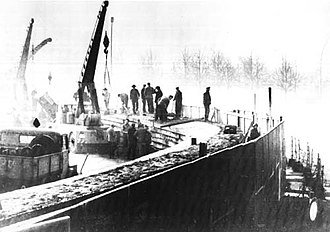WikipediaExtracts:Cold War
Extracted from Wikipedia --
The Cold War was a period of international geopolitical rivalry between the United States (US) and the Soviet Union (USSR) and their respective allies, the capitalist Western Bloc and communist Eastern Bloc, which began in the aftermath of the Second World War and ended with the dissolution of the Soviet Union in 1991. The term cold war is used because there was no direct fighting between the two superpowers, though each supported opposing sides in regional conflicts known as proxy wars. In addition to the struggle for ideological and economic influence and an arms race in both conventional and nuclear weapons, the Cold War was expressed through technological rivalries such as the Space Race, espionage, propaganda campaigns, embargoes, and sports diplomacy.
After the end of the Second World War in 1945, during which the US and USSR had been allies, the USSR installed satellite governments in its occupied territories in Eastern Europe and North Korea by 1949, resulting in the political division of Europe (and Germany) by an "Iron Curtain". The USSR tested its first nuclear weapon in 1949, four years after their use by the US on Hiroshima and Nagasaki, and allied with the People's Republic of China, founded in 1949. The US declared the Truman Doctrine of "containment" of communism in 1947, launched the Marshall Plan in 1948 to assist Western Europe's economic recovery, and founded the NATO military alliance in 1949 (matched by the Soviet-led Warsaw Pact in 1955). The Berlin Blockade of 1948 to 1949 was an early confrontation, as was the Korean War of 1950 to 1953, which ended in a stalemate.
US involvement in regime change during the Cold War included support for First World anti-communist and right-wing dictatorships and uprisings, while Soviet involvement included the funding of Second World left-wing parties, wars of independence, and dictatorships. As nearly all the colonial states underwent decolonization, many became Third World battlefields of the Cold War. Both powers used economic aid in an attempt to win the loyalty of non-aligned countries. The Cuban Revolution of 1959 installed the first communist regime in the Western Hemisphere, and in 1962, the Cuban Missile Crisis began after deployments of US missiles in Europe and Soviet missiles in Cuba; it is widely considered the closest the Cold War came to escalating into nuclear war. Another major proxy conflict was the Vietnam War of 1955 to 1975, which ended in defeat for the US.
The USSR solidified its domination of Eastern Europe with its crushing of the Hungarian Revolution in 1956 and the Warsaw Pact invasion of Czechoslovakia in 1968. Relations between the USSR and China broke down by 1961, with the Sino-Soviet split bringing the two states to the brink of war amid a border conflict in 1969. In 1972, the US initiated diplomatic contacts with China and the US and USSR signed a series of treaties limiting their nuclear arsenals during a period known as détente. In 1979, the toppling of US-allied governments in Iran and Nicaragua and the outbreak of the Soviet–Afghan War again raised tensions. In 1985, Mikhail Gorbachev became leader of the USSR and expanded political freedoms, which contributed to the revolutions of 1989 in the Eastern Bloc and the collapse of the USSR in 1991, ending the Cold War.
